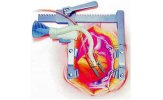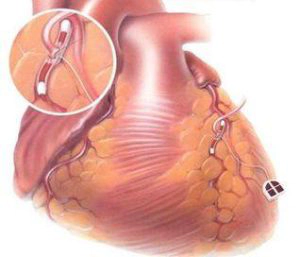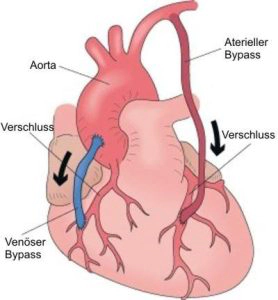Surgery of the coronary vessel

Coronary bypass surgery has been established in recent decades as the global standard surgical procedure for treating coronary artery disease alongside conventional treatment strategies, such as balloon and/or stenting. Today, it accounts for about 60-70% of the total surgical spectrum of cardiac surgery and includes conventional aorto-coronary venous bypass (ACVB) procedures with a cardiopulmonary bypass machine and several other modern and innovative therapeutic options.
- Conventional aortocoronary venous bypass (ACVB) surgery with a cardiopulmonary bypass machine.
- Endoscopic and/or minimally invasive vein removal.
- Bypass surgery without a cardiopulmonary bypass machine (OPCAB)
- Minimally invasive direct coronary artery bypass surgery (MIDCAB)
- Total arterial myocardial revascularisation
- Hybrid procedures (combination of bypass surgery and cardiac catheterization surgery)
Conventional aortocoronary venous bypass (ACVB) with cardiopulmonary bypass machine
This procedure is performed under total anesthesia and is one of our standard coronary artery bypass surgery procedures. After opening the sternum, cardiac arrest is induced by a special cardioplegic solution, while the cardiopulmonary bypass machine maintains the patient’s circulation and oxygen supply. After the bypass vessels are placed, the better-perfused heart resumes its function. The bypass vessels used are the left internal thoracic artery and the patient’s veins from the medial side of the thigh and tibia. In our clinic, the vein is prepared endoscopically or minimally invasively to minimize wound infections and wound healing disorders and achieve an excellent aesthetic result.

OPCAB (Off-Pump Coronary Artery Bypass)
This method represents a modern surgical option in which a cardiopulmonary bypass machine is not necessary. With the help of different stabilizers, the target vessels of the heart are stabilized and can be perfused accordingly. Avoiding a cardiopulmonary bypass machine is associated with a significantly lower risk of stroke and is advantageous in patients with recent infarction or existing impaired lung and/or renal function.
MIDCAB (Minimally Invasive Direct Coronary Artery Bypass)
This procedure is a minimal variation of the OPCAB technique and makes sense in patients with isolated coronary artery disease in the anterior heart wall. The internal thoracic artery is most commonly used as the bypass vessel. The surgical approach is performed directly through a small left anteroposterior incision about 6-8 cm long. The use of a cardiopulmonary bypass machine is not necessary here either.
Total arterial myocardial revascularisation
In this technique, only arterial vessels are used. Due to their different walls, arteries, unlike veins, are more stable and have a more robust muscle layer. Thus, they can better adapt to the perfusion pressure and existing flow conditions and have a better and longer opening rate in many patients. Typical bypass vessels are the two arteries of the chest wall, the radial artery. Arteries from the abdomen (e.g., gastroepiploic artery) are used less frequently. Since the preparation of abdominal wall arteries is a time-consuming process and, in some instances, may result in impaired sternal perfusion, this method is mainly used in younger patients.
Hybrid operations
Hybrid procedures are a combination of bypass surgery and cardiac catheterization. Patients with an indication for hybrid surgery are presented to the multidisciplinary board, where the individual procedure is discussed and determined (see hybrid surgery).
